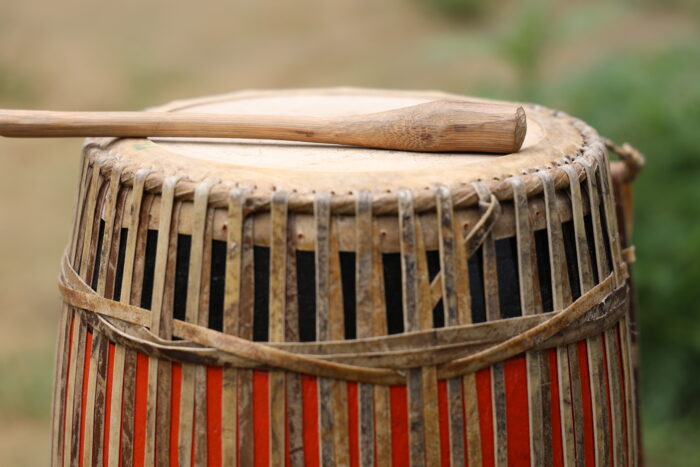Membramophone
Assamese
Dhol(Drum):
A log of Jackfruit or Gamble wood about two cubit long is scooped out in the middle with a chisel. The two drum heads are covered with cowhide and tightened with the help of braces. The right drum head is operated with a drumstick and the left drumhead with the hand. It has thirteen constituent parts : (i) Khola (the body shell) (ii) Koba or Kobani (right drum head) (iii) Tali (left hand drum head) (iv) Maulua or Bandhani (caterpillar device consisting of an endless chain made of braces encircling the left drum head) (v) Katani Chal (thin small piece of animal hide wrapped round the left drum head) (vi) Puligathi (vii) Barati (braces) (viii) Pharinga (tiny piece of bamboo stick for adjustment of the braces) (ix) Kanaijori (rope) (x) Tikani (a device for binding the Konaijori ) (xi) Makhi (tiny pieces of brace put under the Katani Chal) (xii) Kural (ring made of bamboo strip) and (xiii) Dholmari (Drum stick). Over and above these prevalent musical instruments, the tribal population of Assam have their distinctive ones. It is unavoidable in Assamese folk culture. The Dhol is of two varieties : the Bihu drum and the Wedding drum. Some drummers use Junuka (resonant bells) in the Tikoni.

Khol :
The Khol is the most important musical instrument of the Sankari culture (founded by Neo-Vasnvite saint Srimanta Sankardeva in the 14th Century) and Namghar institutions of Assam. According to Katha-Gurucharit “Srimanta Sankaradev got the Khol constructed by the potters of Kopilimukh with the measurement given by him.” The drum shell is made of clay or wood. The right and left drumheads are covered are covered with cowhide and tightened with braces. The main parts of the Khol are 1) Khola or Dima, 2) Daina or Tali, 3) Benwa or Banya, 4) Mulua or Bandhani, 5) Katani Chal, 6) Gher, 7) Barati, 8) Puli, 9) Tikani or Dewali, 10) Ghun, 11) Konaijori and 12) Rupahi. Khol is unavoidable in Bhona, Gyayan-Bayan, Bhagawat Jatra, Sankari or Sattriya Dance, Bargeet performances.

Dagar :
Dagar is a hollowed out piece of wood about 4 inches deep and 7 to 8 inches diameter and covered with animal hide. It is held with the left hand at the rim and is played with the right hand palm mainly in accompaniment with folk songs of Kamrup and Goalpara. The sound of instruments made of iguana hide is more suitable.
Nagara :
A pair of small kettle drums is played upon with two sticks in accompaniment with singing Nagaranam and other devotional songs like Dihanam, Tokarigeet and others.
Dambaru :
It is made of a piece of wood 9 inches long and 5 inches in diameter. Both the ends are hollowed out by means of a chisel. The middle portion of the block is narrowed to the extent of the grip of the palm. The drum heads are covered with animal hide and tightened with braces. Two ropes are attached to the middle with the heads laden with balls of cloth played by shaking the bells with manual technique. Prevalent since ancient times it is believed to be the auspicious musical instrument of God Siva.
Mridanga :
Mridanga is one of the very ancient musical instruments. It was originally made of clay but now from wood. It is about one and half cubit long. The diameter of the left side is 12 or 13 finger width and that of the right side is 11 or 12. It is covered with cow-hide. The middle portions are pasted with the powder of scoria. It is of two varieties. It is unavoidable in Satriya dance and songs, Gayan-Bayan and theatrical performance or Bhaona.
Doba (Large Cattle Drum) :
The Doba is made of an enlarged shell of clay, wood or metal covering with animal hide. It is played by means of two wooden sticks. It is accompanied with morning and evening rounds of religious functions of Namghar and to warn people of imminent danger. It is believed that evil spirits are frightened at the sound of the Doba.
Hajong Tribe
Khomok :
It is made from a wooden shell covered with goat’s hide. Devotional songs are attached with this instrument.
Gowalporiya
Dhak :
It is made of a wooden shell covered with animal hide. It is used in religious functions, songs and dances.
Dhol : It is smaller in size than the normal drum bulging at the middle. It is played in the Bans-puja festival and other dances and songs. Its size and instrumentation vary from place to place.
Tea Tribe
Haridhol : It is a bit smaller than the Dhak. It is played only in auspicious festivals and kept in the place of worship.